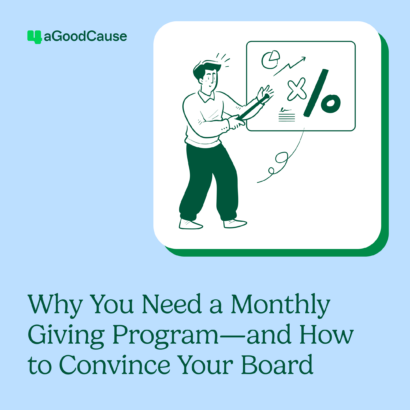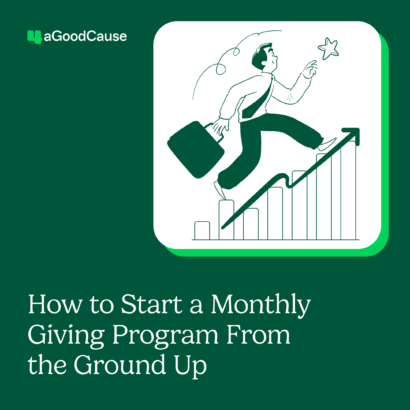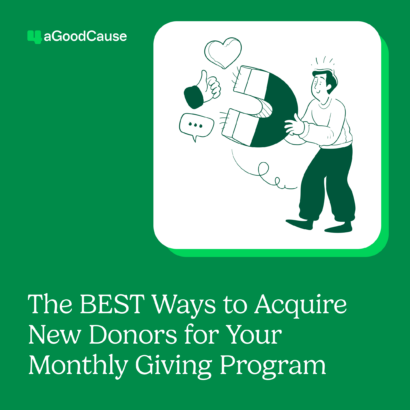For success in online fundraising, nonprofits need to be able to adapt to new trends and technologies. Of course, dedicating too much time and infrastructure to every passing fad is a costly, short-term strategy. You’re too smart for that!
When it comes to online fundraising, two relatively recent trends with staying power that are worth investing in are crowdfunding and peer-to-peer fundraising.
Crowdfunding campaigns are fundraising campaigns that all lead back to one donation page, called a crowdfunding page, which anyone can donate to. These pages are visually interesting, branded to your organization, and spread through social networks. Crowdfunding usually brings in small gifts since gifts are publicly displayed on the page.
Peer-to-peer fundraising is more involved: your nonprofit’s supporters all get their own fundraising page that they ask their own friends and families to donate to. Though each fundraiser collects money through their own peer-to-peer fundraising page, your nonprofit supplies the software and any supplementary materials to help them raise more.
These two methods of fundraising have exploded in popularity with online donors, making them a popular choice for nonprofits. But just because they’re popular doesn’t mean they’re the best option for all nonprofits.
To ensure that crowdfunding, peer-to-peer fundraising, both, or neither are the right choice for your nonprofit, read through this helpful guide in which we focus on how the two differ in three key areas:
- Specialized software requirements
- Marketing and communication strategy
- Integration with other fundraising efforts
After reading this post, you’ll walk away with a greater understanding of the differences between crowdfunding and peer-to-peer fundraising. More importantly, you’ll know if either, both, or neither are the best choice for you.
If you’re ready to find your next online fundraising campaign, keep reading!
1. Specialized software requirements
As with any online fundraising method, both crowdfunding and peer-to-peer fundraising require specialized technology. Many all-in-one online fundraising solutions will include modules or add-ons that facilitate crowdfunding or peer-to-peer fundraising. Specialized solutions exist for smaller nonprofits or any nonprofit wanting to try out crowdfunding.
Whether you’re using comprehensive online fundraising software pre-configured with crowdfunding or peer-to-peer fundraising features or if you’ll need to purchase a point solution, here are the requirements you’ll need for each method:
Crowdfunding: Software requirements
To launch a crowdfunding campaign, your nonprofit needs a place to host it. That place is a crowdfunding page. Nonprofits can host their crowdfunding pages on online platforms or within their all-inclusive online fundraising solution.
Using either hosting option, you’ll need to ensure you have access to some important features:
- Branding: You want your donors to know when they’ve landed on your page. Donors are more likely to trust a page with official branding to handle their payment information.
- Pictures and videos: The more visually interesting your crowdfunding page is, the more likely your donors are to stay on it and give.
- Social media sharing: Crowdfunding relies on social networks to spread, so make it easy for your donors to tell their friends about your campaign using pre-written social media templates, inspired by these great examples from Fundraising Letters.
- Updates: Post updates about the campaign to give your supporters a reason to check the crowdfunding page.
Larger nonprofits that already use all-in-one online fundraising software likely already have access to their own crowdfunding platform. Having complete control over crowdfunding pages pays off for these larger nonprofits in flexibility (especially with branding) and lower transaction costs.
Nonprofits without inclusive fundraising solutions can still take advantage of crowdfunding! The cost-efficient method for smaller nonprofits is to go with a third-party platform. Transaction and platform fees are more manageable than the cost of purchasing a crowdfunding platform.
Peer-to-peer fundraising: Software requirements
A peer-to-peer fundraising campaign requires more specialized software. Unlike crowdfunding, you don’t just launch one peer-to-peer fundraising page for all of your donors to use.
Instead, you need a network of individual fundraising pages for all of your supporters to track their individual donations. You’ll also need a core page for your campaign to share updates, showcase individual fundraisers, and keep everyone up to date on progress toward the overall campaign goal.
Your nonprofit will still need to manage all of these individual pages, though, even though it’s your supporters who will be using them most often. Your nonprofit’s technology team (or a nonprofit technology consultant) will need to ensure that all your supporters’ pages look legitimate and engaging. Otherwise, no one will donate to them!
Setting up a peer-to-peer fundraising page template should be your first step. Then, compile a list of website design best practices and plenty of examples of nonprofit web design for your supporters to customize their pages in ways that will appeal to their own social circles.
2. Marketing and communication strategy
Someone has to get the word out about your campaigns. After all, donors can’t contribute to a campaign they don’t know exists.
But who handles the marketing and how you communicate to donors differs widely between the crowdfunding and peer-to-peer fundraising models.
Crowdfunding: Marketing and communications
Crowdfunding campaigns tend to attract small to mid-sized donations. Major donors are less likely to give large gifts through a public crowdfunding page than through a private donation form or through, in the case of more sensitive areas like healthcare philanthropy, a special arrangement with your nonprofit’s major gift officer.
As such, the success of a crowdfunding campaign lies in its reach. Your nonprofit has to attract as many small to mid-sized donations as possible to reach your goal in a timely manner. That means reaching out via any means necessary, such as:
- Direct mail, to current donors.
- Email, to current and past donors.
- Social media, to current and prospective donors.
Social media, in particular, is a valuable tool for crowdfunding because of its reach. If you ensure that your crowdfunding page is mobile-optimized and easy to share on the most common platforms, then your donors will share a link when they donate and encourage their friends to do the same.
Peer-to-peer fundraising: Marketing and communications
Marketing a peer-to-peer fundraising campaign is a two-step process. First, you have to market the campaign to your supporters, encouraging them to participate as a fundraiser. Then, they have to market the campaign to their own social networks.
You’ve got the first step under control. Though you might need to tweak your message a little, you’re used to communicating the reasons for your campaign to your donors. It’s the second step that requires more careful attention. Your supporters are enthusiastic, but chances are they aren’t fundraising experts like you.
So to help them along in their peer-to-peer fundraising efforts and ensure a healthy influx of donations, you should supply your fundraisers with:
- Suggestions for who to reach out to.
- Social media and email
- Ways to contact you for advice.
- Recognition when they achieve milestones.
With these materials and your expert coaching, your peer-to-peer fundraisers will feel confident sharing their pages with their friends and family.
3. Integration with other fundraising efforts
Crowdfunding and peer-to-peer fundraising campaigns require extra consideration from your fundraising team. Because of that specialized effort, these fundraising methods are better suited to specific situations instead of everyday fundraising.
Crowdfunding: Fundraising integration
Crowdfunding pages are often set up for causes that pop up quickly, such as disaster relief, memorial funds, or emergency medical situations. That’s because they’re easy to set up and easy to share.
Because sudden needs are often, by nature, time-sensitive, you won’t always have the time for a long-term campaign plan with a quiet phase, targeted prospect research, and careful marketing.
Instead, you need something up quickly so you can start collecting funds for your mission right away. Crowdfunding pages are the solution.
These types of campaigns are also useful to pair with a fundraising event, especially for close-knit communities. The relatively low average gift size, public list of donations, and reliance on social networking make crowdfunding the perfect add-on to a community fundraising event.
Peer-to-peer fundraising: Fundraising integration
Many nonprofits also integrate peer-to-peer fundraising into fundraising events, but in a much different way.
When hosting a charity walk, run, or ride, nonprofits can use peer-to-peer fundraising milestones instead of tickets to reserve places at the starting line.
Though raising money for a spot in the race is the most popular way to incorporate peer-to-peer fundraising into a fundraising event, there are other options that might work better for other kinds of fundraising events:
- Cultural- and arts-focused nonprofits can host peer-to-peer fundraising campaigns for perks, such as backstage access to a charity concert or popular museum programming.
- Educational nonprofits can take advantage of healthy competition between classes of students in team peer-to-peer fundraisers to fund a field trip. (For more ways schools can fundraise, check out this guide!)
- Any nonprofit hosting a fundraising event can offer prime seating, early admission, or special recognition (such as a shoutout in a speech or a ribbon to pin on their lapel) to the highest-earning peer-to-peer fundraisers.
Integrating a peer-to-peer fundraising campaign into a greater fundraising strategy isn’t always feasible. For the money and time invested in specialized software and coaching individual fundraisers, your nonprofit has to have enough supporters willing to participate.
Earning special event perks by reaching a peer-to-peer milestone is only an effective motivator when the perk is something your supporters want.
If you’re looking for a different kind of online fundraiser to energize your supporters, crowdfunding and peer-to-peer fundraising fit the bill — on paper, at least. Before diving in, make sure you understand the differences in how they’re implemented and whether they’re right for your nonprofit.



